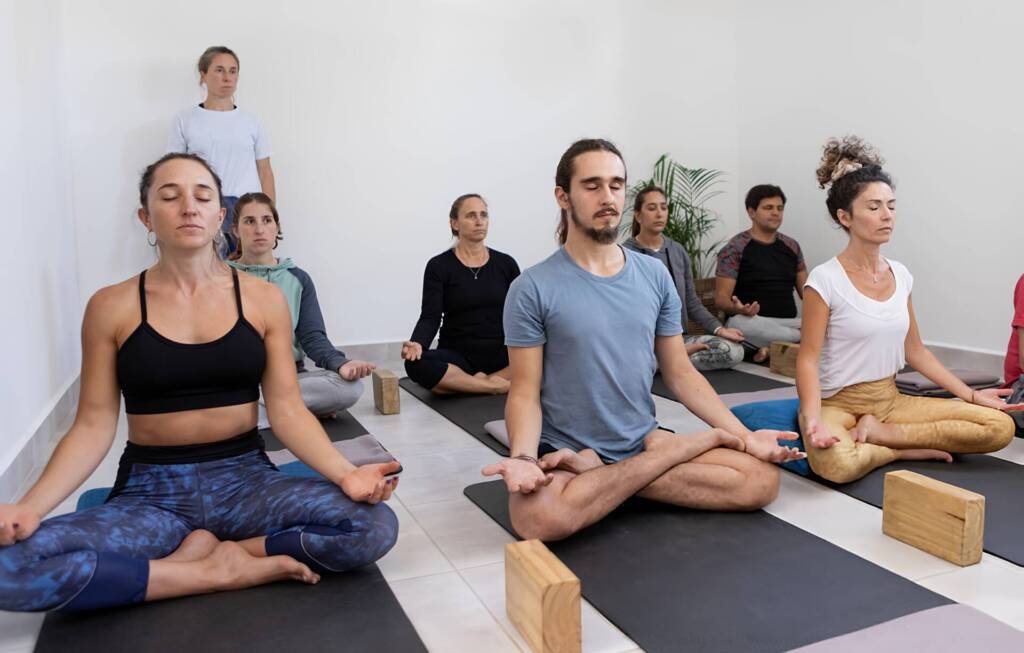Meditation instruction plays a pivotal role in guiding individuals toward mindfulness, clarity, and personal growth. This beautiful practice has traditionally been taught face-to-face, grounded in shared spaces that nurture connection and calm. However, with the rise of technology, teaching meditation has transcended physical boundaries, unlocking a digital landscape full of potential.
Table of Contents
Today, meditation instructors have the opportunity to choose between teaching online, offline, or even blending the two approaches. Each has unique strengths and hurdles, making the choice a profoundly personal one based on goals and circumstances.
This blog explores the challenges and benefits of teaching meditation online vs. offline, offering actionable insights to help you excel, no matter which approach you pursue.
What Does Effective Meditation Instruction Look Like?

Effective meditation instruction is about creating a space for meaningful transformation, whether in person or online. It goes beyond simply teaching techniques—it’s about guiding students into mindfulness, cultivating trust, and fostering an environment where personal growth can thrive. A skilled meditation teacher serves as a guide on this inner journey, providing support, insight, and encouragement every step of the way.
The arrival of digital platforms has disrupted traditional in-person instruction, giving meditation teachers the ability to reach students across the globe, no matter their location. Virtual classes, apps, and online communities have made mindfulness practices more accessible than ever, opening doors for people who may not have had access to in-person sessions.
While technology can never fully replace the energy and authenticity of face-to-face interaction, it provides an undeniable opportunity for greater connection, inclusivity, and flexibility. This shift has also encouraged teachers to adapt their methods to engage students in meaningful ways through screens, proving that growth and transformation can still thrive in a digital format.
Teaching Meditation Offline (Traditional Methods)

Meditation has long been taught in person, creating opportunities for instructors and students to meet in serene, peaceful spaces, share energy, and immerse fully in the present moment together. This traditional approach has been cherished for its ability to foster deeper connections and a more holistic learning experience.
Benefits of Offline (In-Person) Meditation Teaching
- Stronger Connection: Face-to-face interaction allows instructors to build a more meaningful connection with their students. Being physically present helps them respond intuitively to subtle cues like body language, energy shifts, or even the tone of a student’s voice. This immediate feedback enables a level of understanding that is difficult to replicate in a virtual environment.
- Community Building: Shared physical spaces cultivate a sense of belonging and camaraderie among participants. Students often feel more bonded when meditating together in person, creating a supportive group dynamic that can enhance their overall experience. This sense of community can motivate students to remain consistent in their practice and even foster friendships outside the meditation class.
- Enhanced Observation: In-person teaching allows instructors to notice small but important details, such as changes in posture, restlessness, or breathing patterns. These observations help instructors provide more personalized guidance in real-time, ensuring each student receives the support they need to deepen their meditation journey effectively.
In-person meditation teaching nurtures a more personal and tactile experience, enriching the journey for both students and teachers alike. It’s a timeless practice that continues to offer profound benefits even in today’s digital age.
Challenges of Teaching Offline
- Geographic Limitation: Traditional instruction methods often limit you to serving students within your local area, making it difficult to reach a wider audience. This can be incredibly challenging if you aim to grow your business or connect with students in different regions or countries.
- High Costs: Renting physical spaces, purchasing necessary props or equipment, and managing administrative tasks can quickly add to your expenses. These logistical challenges not only drain resources but also add complexity to maintaining a profitable and efficient operation.
- Time Constraints: Sessions usually require fixed schedules, making it harder for students and instructors to find flexibility. Coordinating these sessions can pose challenges, particularly when dealing with varying commitments, time zones, or unexpected changes in availability.
Tools for Success in Offline Teaching

Here are some essentials for creating a calming and effective offline environment:
- Set the Mood: Create a soothing atmosphere by incorporating calming elements like candles, incense, sound bowls, or soft lighting. Consider adding relaxing music or nature sounds to enhance the ambiance further and promote a sense of peace.
- Provide Basics: Ensure students are comfortable by providing essentials such as yoga mats, supportive cushions, and cozy blankets. These items improve comfort and help participants feel grounded and focused during the session.
- Master Facilitation: Invest time in honing your facilitation skills by thoughtfully designing group sessions. Incorporate techniques to manage the group’s energy effectively, ensure every participant feels recognized and heard, and cultivate a sense of connection and camaraderie. Adapt your approach to suit the group’s unique needs, creating a more meaningful and impactful experience.
Teaching Meditation Online

The ability to teach meditation online has revolutionized the practice, empowering instructors to share teachings far and wide. Gone are the days when proximity determined participation—now, anyone with an internet connection can meditate along with you.
Benefits of Teaching Meditation Online
- Global Reach: Online teaching allows you to connect with students from any corner of the world, removing geographical barriers and vastly expanding your audience. This global accessibility fosters diverse learning environments and unique opportunities for cultural exchange.
- Cost Efficiency: With no need for physical classrooms or travel expenses, online instruction significantly reduces student and teacher costs. This affordability makes education more accessible to a broader range of learners.
- Flexibility: Online learning offers adaptable scheduling, allowing students and instructors to work around their personal commitments and cater to different time zones. This flexibility makes balancing education with work, family, or other responsibilities easier for both parties.
- Scalability: Whether you record sessions for later use, create comprehensive online courses, or host live webinars, online teaching provides the tools to cater to larger audiences without losing quality. This scalability enables you to maximize your reach and impact efficiently.
Challenges of Online Teaching

- Building Connection: Fostering trust and intimacy through screens can feel challenging without the natural comfort of physical presence. Establishing a genuine connection may take more time and effort, as non-verbal communication, like body language, is less apparent in virtual settings.
- Technical Issues: Interruptions due to slow internet speeds, poor audio quality, or other tech glitches can disrupt the flow of a session and lead to frustration for both parties. These issues can create barriers to effective communication and may require troubleshooting that takes time away from the session itself.
- Reading Energy Remotely: Observing subtle physical or emotional cues, such as body posture, micro-expressions, or shifts in tone, becomes far more complicated when interacting through a screen. This can make it harder to fully understand and respond to the other person’s emotions or needs.
Tools and Techniques for Online Meditation Success

Elevate your virtual meditation sessions with these strategies for a more impactful and engaging experience:
- Choose the Right Platform: Selecting the right platform is key. Popular tools like Zoom and Microsoft Teams offer flexibility, while dedicated apps like Insight Timer cater specifically to meditation instructors, providing features like timers, soundscapes, and community engagement tools to enhance the session.
- Upgrade Your Equipment: High-quality audio and visuals make a huge difference. Invest in a professional-grade microphone to capture your voice clearly and a high-definition camera to create a polished, professional look. This ensures your students can focus without distractions caused by poor sound or video quality.
- Visual Aesthetics: Create a calming and inviting environment for your sessions. Use soft lighting, neutral tones, and soothing visuals, such as plants, candles, or simple artwork. A clutter-free, serene backdrop sets the tone and helps students feel relaxed and focused.
- Personalized Engagement: Make your students feel genuinely seen and supported by offering interactive elements. Consider including live Q&A sessions after the meditation, providing one-on-one feedback, or sending follow-up messages with additional resources or encouragement. This personal touch builds stronger connections and enhances the overall experience.
Teaching Meditation Online vs Offline
Visualizing the differences between online and offline teaching can help you select the approach that best aligns with your teaching style. Below is a side-by-side comparison of their key characteristics:
| Aspect | Offline Teaching | Online Teaching |
|---|---|---|
| Reach | Limited to local students | Global audience |
| Costs | Higher overhead (renting space, materials) | Lower overhead (minimal setup required) |
| Connection | Builds deeper, in-person relationships | Trust-building through interactive tools |
| Observation | Easier to assess nonverbal cues in person | Limited ability to observe body language |
| Flexibility | Fixed times and locations | Flexible scheduling for all time zones |
When to Choose Offline or Online
- Offline teaching is ideal for beginners who value human connection and hands-on, in-person guidance. Being physically present in a class allows for immediate feedback, a stronger sense of community, and a distraction-free environment to fully immerse yourself in the practice.
- Online teaching works best for experienced meditators or those with busy schedules who need flexibility. Virtual sessions allow you to practice anywhere, save travel time, and choose from a broader range of instructors and styles that suit your needs.
Tips for Choosing the Right Approach

Ultimately, deciding between teaching meditation online and offline depends on your unique strengths, audience, and goals. Both approaches have advantages, and understanding what works best for you and your audience is key to creating meaningful and impactful sessions.
Ask Yourself These Questions
- Who is my target audience? Will they prefer in-person interaction, where they can connect face-to-face and immerse themselves in a calming environment? Or do they value the convenience and flexibility of virtual sessions they can join from the comfort of their own homes?
2. Do I feel more comfortable teaching behind a screen or in a physical room of students? Consider whether you thrive on the energy of a live group or if you prefer the structured, tech-friendly setup of online teaching.
3. What resources and tools do I have access to that will enhance the experience? For online sessions, this might include video conferencing software, quality lighting, and a reliable microphone. For offline sessions, think about spaces that promote relaxation, such as studios or community centers, and how you can create a welcoming atmosphere.
Taking the time to reflect on these questions will help you decide on the right format and ensure a more fulfilling experience for both you and your participants.
Consider a Hybrid Model
Why settle for one approach when you can combine the strengths of both? A hybrid model allows you to host in-person sessions when possible while also connecting with wider audiences through online classes. Here’s how to get started with a hybrid mindfulness teaching strategy:
- Alternate between in-person and virtual sessions to provide flexibility and cater to students’ varying preferences and schedules.
- Record live sessions so your online students who couldn’t attend in real time can still benefit from the class. This also allows students to revisit sessions for extra practice.
- Build a comprehensive library of pre-recorded meditations that students can access anytime, giving them the freedom to practice at their own pace and convenience.
Final Words
Online and offline teaching both offer great ways to help students find calm and deepen mindfulness. Whether you’re leading a group in a serene studio or guiding sessions on a virtual platform, the key is to adapt your approach to suit your strengths and your audience’s needs. Offline classes build connection and community, while online teaching breaks geographic barriers to reach students anywhere.
If you’re ready to take your meditation practice to the next level, **explore our beginner’s guide to teaching meditation online**. This guide is packed with tools, tips, and techniques to help you extend your reach while maintaining the personal touch that makes your sessions impactful. With dedication, creativity, and adaptability, you could become a driving force in building a global mindfulness movement.
What about you? What have been your biggest challenges or successes with teaching meditation, whether online or offline? We’d love to hear about your experiences. Share your thoughts below!





